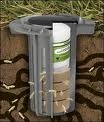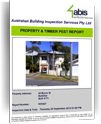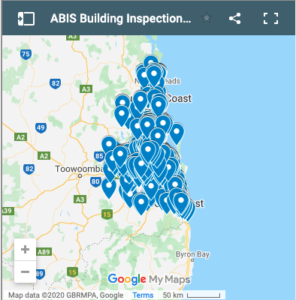Termites cause so much damage because their secretive nature means their entry often goes undetected through in-fill panels, expansion joints, cracks in concrete slab flooring, or under parquetry and floor tiles until structural timbers sustain substantial damage. Slab-on-ground construction of properties has enabled easier termite access at slab edge, through cracks, joints and imperfections in the concrete or around service pipes to enter walls undetected.
Clearing land has removed mound building species, providing opportunities for more secretive multi-site nesting species. Severe termite damage to Australian homes is on the increase since the removal of long lasting soil barrier chemicals; the more common use of softwood building and landscaping materials together with building designs, automatic watering systems, landscaping and poor maintenance all of which encourage hidden termite activity.
To compound the problem, Home or Building Insurance Policies generally will NOT cover the repair costs of any timber damage caused by termites to your home.
Prevention Starts With Good Home Maintenance & Regular Inspections
Moisture is essential to termite survival and a major attractant. Minimising moisture from in and around the dwelling is half the termite prevention battle.
Maintenance Should be Undertaken Before Implementing Other Measures
-
Regularly inspect the condition of gate posts, fencing, and pergolas attached to the house
-
Keep gardens away from the dwelling and do not cover over weep holes. Garden beds should be a minimum 100 mm below weep holes and pathways a minimum 75mm below weepholes
-
Avoid landscaping with bark chips and irrigation systems against the house
-
Don’t plant vines, trees and plants close to the house where roots may disturb a chemical barrier or provide access
-
Remove sources of moisture e.g. overflows from water heaters and air conditioners which are not directed to a drain, leaking and dripping taps, faulty plumbing and loose tiling and grout in showers, baths and kitchens. Regularly monitor for signs of dampness in wall cavities, broken roof tiles, faulty guttering. High humidity, dampness or moisture accumulating in a wall cavity has a high risk of encouraging large scale termite activity inside a building
-
Improve ventilation to subfloor spaces
-
Monitor and seal points where plumbing, electrical and telecommunications services penetrate the slab or enter sub-floor areas
-
Ensure paving or concrete pathways adjoining the house do not breach termite barriers
-
Inspect weep holes, vents, and other entry points regularly for termite shelter tubes or mudding
-
Remove timber in contact with soil which provides a food source
-
Ensure inspection access is unimpeded, especially in subfloor areas
- Ensure alterations or additions to a building have appropriate protection and do not breach or allow termites to bypass existing barriers
Protection: Chemical Options
Chemical Soil Barrier
Chlorinated hydrocarbon insecticides e.g. chlordane, heptachlor, aldrin, and dieldrin have been banned since 1995, and replaced by the organophosphorus insecticide chlorpyrifos, the pyrethroid bifenthrin and the chloronicotinyl imidacloprid. Soil barriers are established by trenching around the foundation and treating the soil with an emulsion of chlorpyrifos. There must be a 150 mm wide 300mm deep chemically treated area around the entire building. Garden beds should be a minimum 100 mm below weep holes and pathways should be a minimum 75mm below weep holes. However, chemical soil barriers do not kill the colony – their function is purely to exclude termites from the building. There must be absolutely no untreated soil through which termites can gain access to building foundations or footings or any disturbance of the chemical barrier which may allow termite access.
Chemical Reticulation Systems
Perforated PVC plastic piping placed under a building provides soil access for distribution of chemicals every 3-5 years.
Chemical Moisture Barriers
A termiticide (e.g. deltamethrin) applied to a matrix is sandwiched between two layers of plastic moisture barrier making special provision for sealing areas where facilities such as plumbing and electricity pass through.
Termite Resistant Materials
Where structural elements of a building e.g. roof trusses, lintels, top plates, noggings, and bottom plates consist of masonry, steel, naturally resistant timber or treated timber, termite damage is minimised.
Chemically Treated Timber
Preservative treatment of timber with copper chromium and arsenic or Boron.
Naturally Resistant Timber
American Redwood, Black Bean, Blood Wood, Jam Acacia, River Red Gum, Southern Cypress, White Cypress, Jarrah, and Hoop Pine, are resistant although not to all species.
Steel Framed Houses
A steel frame is impervious to termites; however other building materials in the structure may still attract termites and therefore will still require regular inspections.
Physical Barriers
Termite Shielding
Continuous metal barriers along walls and on top of piers (ant caps) prevent termite access to bearers, joists and structural timbers and more importantly, make their presence visible.
Concrete Slab
This may be a preventative tool where the edge of the slab is exposed for a minimum of 75mm and is laid to Australian Standards.
Finely Divided Granite
This is used under buildings where particular sizes (1.7 – 2.4mm) and shapes prevent transportation of particles as well as termite activity in void spaces between particles.
Stainless Steel Mesh
Fine mesh too small to for a termite to pass through is applied around plumbing intrusions, service penetrations and building perimeters to deter termite access.
Baiting Systems
Timber bait monitors serve several purposes. They provide evidence of termite presence, enable identification of the termite species and a site where an eradication treatment commonly using an insect growth regulator (IGR) can be applied. Bait monitors are made from susceptible species of timber such as doulas fir, radiate pine or mountain ash and are buried in ground. A frequently used bait monitor originally developed by CSIRO consists of a foam plastic box with termite access holes that is filled with timber, cardboard or paper and buried in ground. When the box’s contents are attacked and the termite species identified, an IGR treatment e.g. hexaflumuron, a chitin synthesis inhibitor is introduced and spread throughout the colony until eradication is achieved. Once eradication has been achieved, monitoring is resumed to detect any new activity. Location of bait monitors is critical for both efficacy and safety of treatment.

Common Failures of Termite Barriers
-
Construction on fill/surface rock – termites normally operate in the top 200mm of original soil and are therefore buried deep beneath the construction. Soil treatments to conventional depths may be ineffective.
-
Split-level constructions make it difficult to install a completely continuous barrier.
-
Service facilities to a building also make it difficult to install a completely continuous barrier.
-
Occasionally a slab is laid directly over a termite nest.
Where there is a constant source of moisture within a building, termites may establish a colony in a building without having contact with soil – in these cases, barriers may be ineffective.
It is vital to know what termite management is in place in a property to schedule regular professional inspections and appropriate maintenance. A label describing the protection method, date of installation, life expectancy, and manufacturer’s recommendations for frequency of inspections should appear inside the electrical meter box in any building constructed after 1st July 1997. For buildings constructed between 1986 and 1997, the notice may be fixed at the entrance to a crawl space or in the meter box.
Termite management systems commonly fail when a home is sold without records or there has been a failure to maintain regular annual inspections. Additional landscaping and gardening, tree roots and rodent activity, plumbing and electrical changes and home additions without adequate termite prevention also increase the risk of system failure. Regardless of which termite management system you choose, competent inspections by an independent professional should be conducted at least on an annual basis.




